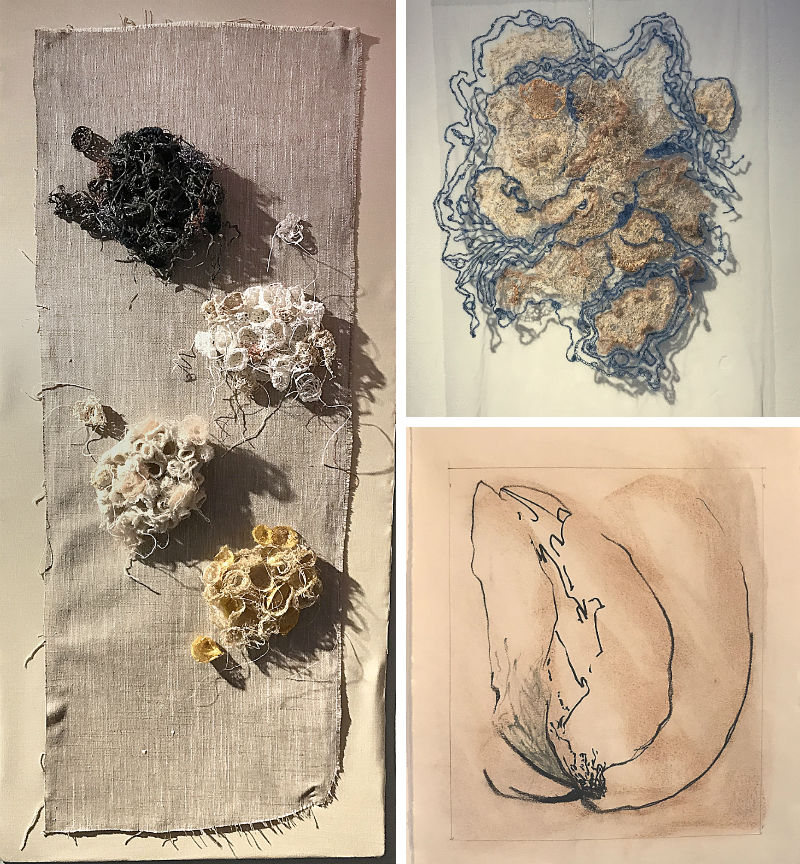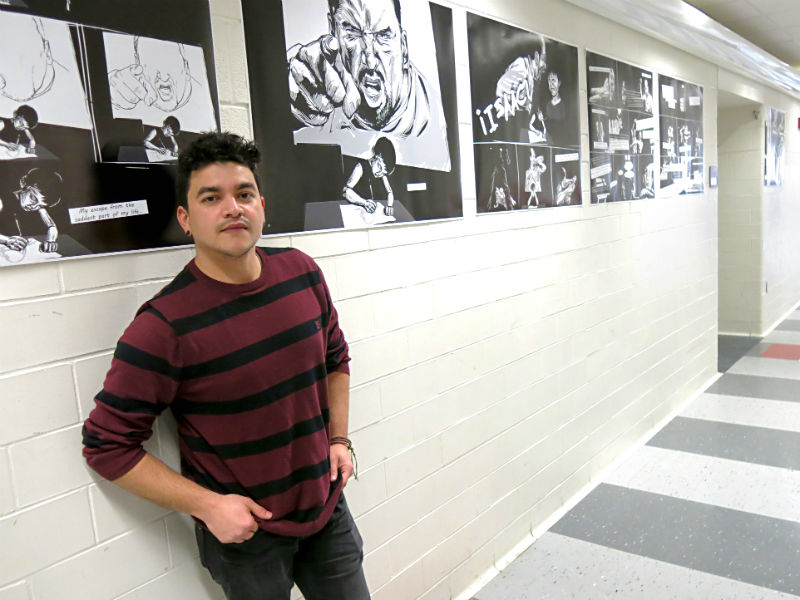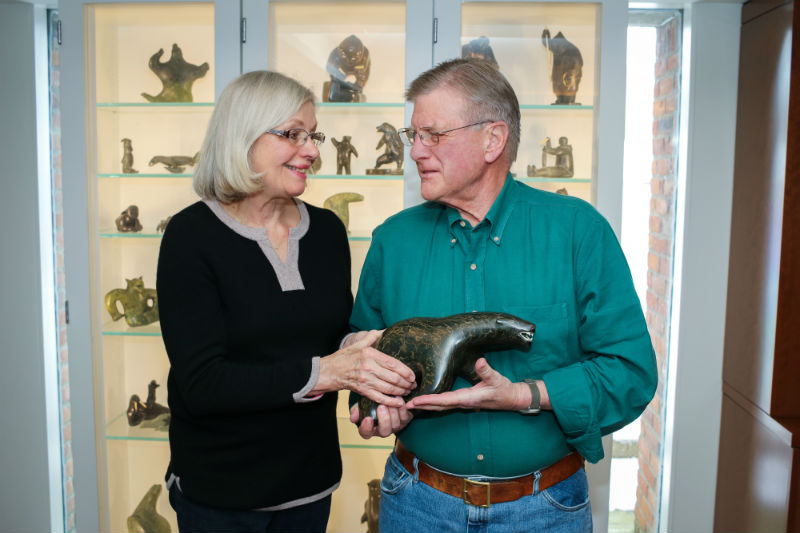A Heavenly Gaze: Allie McGhee's "Cosmic Images 2000" at Rotunda Gallery

Paintings and public sculptures by prominent contemporary artist Allie McGhee abound throughout Detroit. His elegantly gestural Night Rhythms (1991) can be seen at the Detroit Institute of Art. The Michigan-Cass Avenue stop on the People Mover features his work, and right now, a small but exquisite sliver of his decades-long body of work, Cosmic Images 2000, is on view at the Rotunda Gallery in Building 18 of University of Michigan's North Campus Research Center in Ann Arbor through August 31.
McGhee was born in Charleston, W.V., but soon moved to Detroit, where he attended Cass Technical High school. He completed his undergraduate work at Eastern Michigan University in 1965. His early paintings and sculptures were figurative and even as he has moved toward abstraction, his work has retained the gestural sweep of his unseen arm.
John Gutoskey’s “PULSE Nightclub: 49 Elegies" series honors those murdered in Orlando

On June 12, 2016, 49 people died and 53 others wounded when a gunman opened fire at Pulse nightclub in Orlando, Florida. It was then the largest mass shooting by a single person in American history.
John Gutoskey’s PULSE Nightclub: 49 Elegies is a series of monoprints that honor the lives lost at Pulse. The exhibit opens Ypsilanti's 22 North gallery on June 1, the first day of Ypsi Pride events.
Gutoskey has lived in Ann Arbor for many years, and he received his MFA from the University of Michigan’s School of Art and Design and has lectured at the University of Michigan on different aspects of costume design. Now he runs his own printmaking studio in Ann Arbor, all the while exhibiting his work at galleries across southeast Michigan and beyond. Gutoskey’s subtle, mixed-media works are filled with color, arresting images, and a deeply introspective quality. I spoke with him about 49 Elegies, his work in general, and the importance of activism in art.
Patterns in the Process: “Sara Adlerstein: Ecologies, my true colors” at WSG Gallery

Vivid, biomorphic expressions take imaginative turns in Sara Adlerstein’s Ecologies, my true colors at downtown Ann Arbor’s WSG Gallery.
Adlerstein’s mixed-media Ecologies exhibit features biologically themed art crafted largely in dramatic three by four feet proportions. Her all-heart artworks are abstractions based on realism featuring nuanced, organic leitmotifs.
An applied aquatic ecologist and current faculty member at the University of Michigan School of Natural Resources and Environment, Adlerstein hasn’t pursued formal training in the arts. Rather, she says she’s has been painting for as long as she’s been a scientist. “Art and science belong together as naturally as air and water,” Adlerstein wrote in her artist's statement
Minimalesque: “Deborah Campbell and Lois Kane: Burgeoning” at Kerrytown Concert House

There’s minimalist art and there’s art on the edge of being minimal. This distinction may seem paradoxical, but it is one way of describing the Burgeoning exhibit at Kerrytown Concert House by local artists Deborah Campbell and Lois Kane.
Deborah Campbell's art is minimal -- and it's bountiful for it. Where a less talented artist might overpower her work with excess, Campbell strategically stitches her fiber art with just enough effort to convey her articulation. Every stitch counts.
Lois Kane's draftsmanship functions in a similar fashion as Campbell's stitching. Where Campbell’s touch is serene, Kane’s line is vigorous, or memorably spare, and is always on point.
Altering the Landscape: "Written Into Rock" at Ann Arbor Art Center

Ann Arbor Art Center’s current exhibition, Written Into Rock, explores imagery associated with the Earth, geology, and human impact on the environment. Curated by Gina Iacobelli, the exhibition features the works of seven artists dispersed throughout the gallery instead of placing works by each artist together.
The exhibition announcement states that the show “is an exploration of the ways in which humans have altered the natural landscape,” and was in part initially inspired by writings of Donna Haraway and Heather Davis, who explore ideas relating to the Anthropocene era, a “new geologic area defined by human’s mark on the geologic record.”
U-M Gifts of Art spring exhibitions aim to revitalize and renew

Michigan Medicine’s Gifts of Art program regularly supports artists while working to “revitalize and enrich lives” of patients and visitors. The latest Gifts of Art series on display in various parts of University Hospital is available to view through June 10. The eight small exhibits in Gifts of Art's nine galleries feature the works of artists Tina West, Richard Light, John Dempsey, Mary Brodbeck, Aimee Lee, Re Kielar, f8collective, and WCC faculty, staff, and students.
UMMA's "Exercising the Eye" shows how Gertrude Kasle expanded the Midwest art scene in the 1950s

The University of Michigan Museum of Art’s exhibition Exercising the Eye: The Gertrude Kasle Collection presents an array of works by influential artists of the 20th century. Many of these artists, as pointed out by the exhibition organizers, were, in part, brought to prominence in the Midwest by Gertrude Kasle’s (1917-2016) promotion of their works.
"Labors of Love and Loss" exhibition explores race, gender, and class with mixed media

The U-M Institute for Research on Women and Gender and the Department of Women’s Studies exhibition Labors of Love and Loss is a collection of mixed-media pieces exploring gender and race and "considers the intertwined lives of caregivers, their dependents and charges.” The exhibition presents the works of Marianetta Porter and Lisa Olson, featuring processes such as letterpress combined with found objects. Though Porter and Olson’s works differ in some respects, they create a cohesive, important dialogue about the history of women’s work and the intersections between race, gender, and class, expertly portrayed through text and object.
What exactly is the exhibit, and what are the Labors of Love and Loss that the title refers?
Germán Andino addresses Honduran gang violence in the #NoHumanIsAlien exhibition at U-M

Comic-based journalism, where an artist tells reported stories with his or her drawings, has the benefit of addressing sensitive issues with a bit of emotional distance that doesn't always exist in the more immediate video- and audio-based storytelling. It can also give reluctant participants the freedom to tell their difficult and dangerous tales without a direct visual representation, which could put their lives at risk.
Joe Sacco is a pioneer of graphic journalism as shown in his many books, including Palestine (2001), Safe Area Gorazde (2002), and Journalism (2013). In Sacco's wake a mini-movement of graphic journalism has emerged, such as Sarah Glidden’s How to Understand Israel in 60 Days or Less (2016), Wendy MacNaughton's Meanwhile in San Francisco: The City in Its Own Words (2014), and Germán Andino's El Hábito de la Mordaza / The Habit of Silence (2016).
Indigenous Inspiration: Power couple donates Inuit art collection to UMMA

Hail to the University of Michigan Museum of Art -- its Victor campaign just found a new leader in donations and it's the best.
Philip and Kathy Power donated $4.5 million worth of Inuit art, making UMMA one of the most important museums for creative works from the indigenous peoples of Alaska, Canada, and Greenland.


































